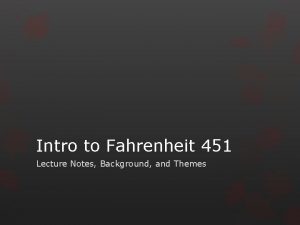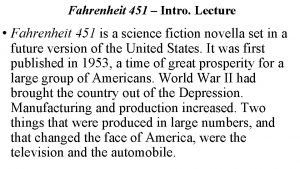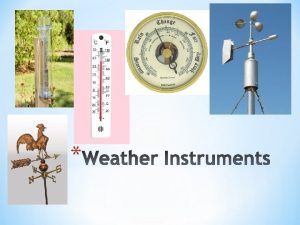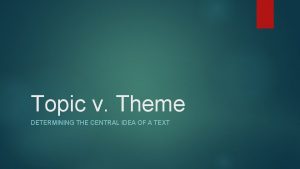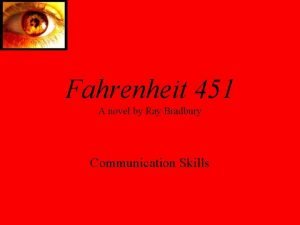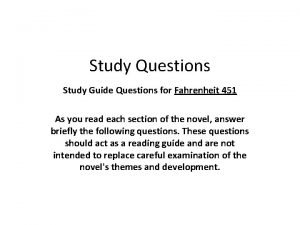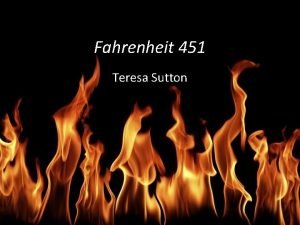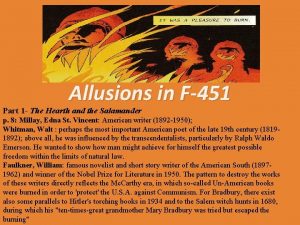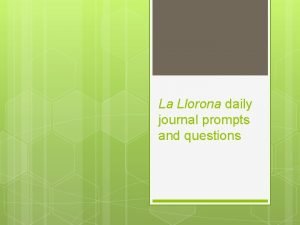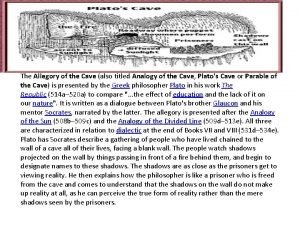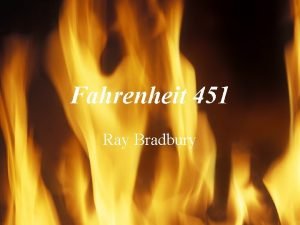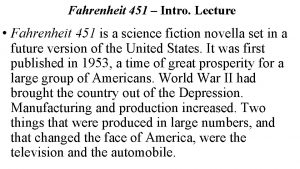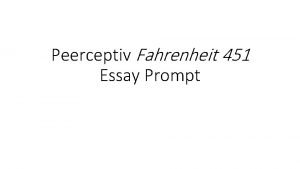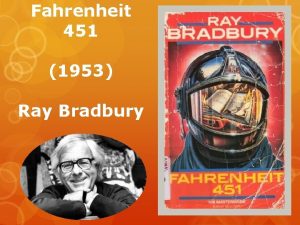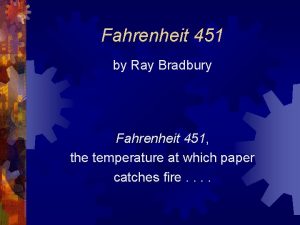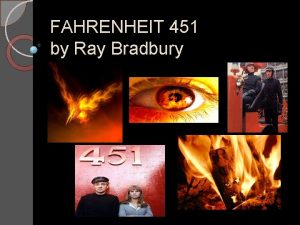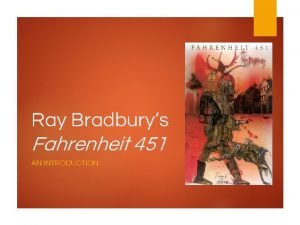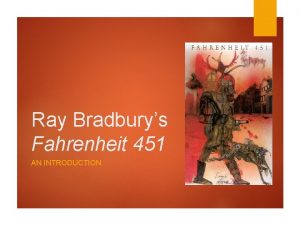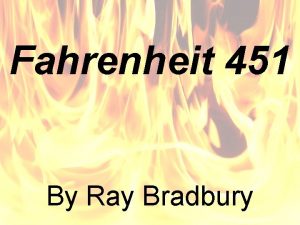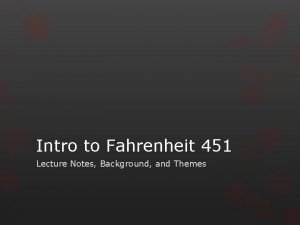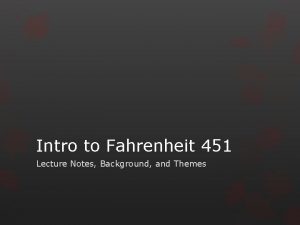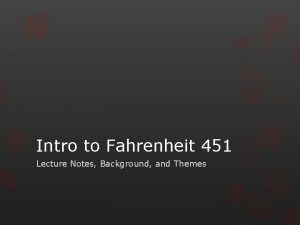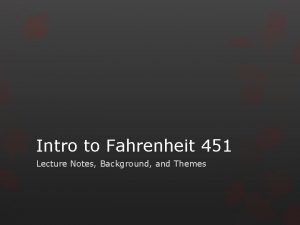Fahrenheit 451 Intro Lecture Fahrenheit 451 is a





















- Slides: 21

Fahrenheit 451 – Intro. Lecture • Fahrenheit 451 is a science fiction novella set in a future version of the United States. It was first published in 1953, a time of great prosperity for a large group of Americans. World War II had brought the country out of the Depression. Manufacturing and production increased. Two things that were produced in large numbers, and that changed the face of America, were the television and the automobile.

Fahrenheit 451 – Intro. Lecture • As more people entered the middle class, they were able to afford televisions. Before World War II, only about 7, 000– 8, 000 television sets had been made in the U. S. Production was halted during the war and resumed in August of 1945. In 1946, only one half of one per cent of United States households had a television set. By 1954 (the year after the release of Fahrenheit 451), 55% of United States households had televisions. By 1962, television sets could be found in 90% of United States homes.

Fahrenheit 451 – Intro. Lecture • Men worked during the day, but women generally stayed home and raised the children. Women, therefore, were a captive audience for television programs broadcast during the day. Children were also a desirable audience. Television changed the way people interacted. Rather than talking to neighbors as a form of entertainment, people began to stay in their homes and watch their favorite television programs.

Fahrenheit 451 – Intro. Lecture • The 1950 s were also a time in which the automobile became extremely important to America. In 1947, still in the aftermath of World War II and industry’s retooling for peacetime, 3, 300, 000 automobiles were produced in the United States. By 1953 (the year of Fahrenheit 451’s release), production had more than doubled.

Fahrenheit 451 – Intro. Lecture • The year 1949 also witnessed the introduction of the high-compression V 8 engine, allowing for faster and more powerful automobiles, and setting off America’s decades-long love affair with speed and power.

Fahrenheit 451 – Intro. Lecture • Coincident with the rise of the automobile was the building of President Dwight D. Eisenhower’s Interstate Highway System (originally called the National System of Interstate and Defense Highways). While the Federal-Aid Highway Act of 1956 (popularly known as the National Interstate and Defense Highways Act) was not signed into law until three years after the release of Fahrenheit 451, variations of Eisenhower’s plan had been circulating since 1921 and had been lobbied for by automobile manufacturers since the end of World War II.

Fahrenheit 451 – Intro. Lecture • New cities and suburbs were planned around the new roads and plentiful, cheap automobiles. Areas that had formerly been wilderness or parks were transformed into residential or business areas. Walking became more rare; the automobile was the preferred method of getting from one place to another.

Fahrenheit 451 – Intro. Lecture • Ray Bradbury, a noted science fiction author, became concerned about the dangers he felt television and automobiles presented to a stable society. Fahrenheit 451 is the book that came out of Bradbury’s vision of the future.

Fahrenheit 451 – Intro. Lecture THE ALLEGORY OF THE CAVE • The ancient Greek philosopher Plato authored a dialogue (philosophical discussion between characters) that we now know as The Republic. In this work, Plato describes the difference between ideals and reality. There are, he says, ideal forms of things which exist only as abstract concepts, but which are the most true and perfect things. Human beings, however, live in a shadow world; they see imperfect reflections of these true forms. In his famous allegory, Plato imagines people sitting in a cave, watching shadows play on a wall. Because the cave is all they know, the people think the shadows are real. When one person is somehow taken from the cave and placed in the Real World, he or she is unable to convince the others of the truth.

Fahrenheit 451 – Intro. Lecture THE ALLEGORY OF THE CAVE • Like biblical prophets, persons who have been “out of the Cave” and know True Reality, are considered foolish or insane by those who still accept the shadow figures on the wall of the Cave as reality. Out-of-Cave prophets are dismissed, ridiculed, discredited, and—often— destroyed.

Fahrenheit 451 – Intro. Lecture GENRE • Fahrenheit 451 is a work of science fiction. Unlike fantasy, science fiction describes things that are plausible, based on the best scientific knowledge at the time. Science fiction often considers the effect that technology might have on society. In Fahrenheit 451, Bradbury speculates that things intended to make life easier and more pleasant— cars, mass media—may actually rob people of the ability to think and relate to one another.

Fahrenheit 451 – Intro. Lecture THEMES Look out for the following themes in Fahrenheit 451: • Progress can actually be dangerous or harmful. • The thinking man or woman will always be at odds with society. • Reason can be used as a weapon to defend wrong as well as right. People should make their own choices and be careful about accepting what they hear.

Fahrenheit 451 – Intro. Lecture MOTIFS Good and Bad Fire: • Fire and burning are important symbols in Fahrenheit 451. Fire can be life-saving; after all, people need warmth to survive. According to one ancient Greek myth, Prometheus (his name literally means “forethought”), a son of Zeus, made human beings out of clay. He then stole fire from the gods for his new creation, allowing people enlightenment and knowledge.

Fahrenheit 451 – Intro. Lecture MOTIFS Good and Bad Fire: • As a symbol, fire has long been associated with technology—the Roman god Vulcan is the god of metalworking, and his forge is under the volcano Mt. Etna. The god Apollo is god of the sun and the god of knowledge—both physical and mental light.

Fahrenheit 451 – Intro. Lecture MOTIFS Good and Bad Fire: • Of course, fire can also destroy. The Prometheus myth contains the warning that if people try to know too much—to steal too much of the gods’ fire —they will pay the price. Prometheus himself was severely punished for his theft on behalf of humankind.

Fahrenheit 451 – Intro. Lecture MOTIFS Good and Bad Fire: • Among other associations of fire, life, and death are the phoenix and the salamander. The phoenix is a bird that destroys itself in a fire and then rises again from its own ashes. The lizard-like salamander was once thought to be generated by fire. (This belief is thought to have originated in the fact that many salamanders live in rotted logs. When the log is thrown onto a fire, the salamander flees, thus giving the appearance that it originated in the fire. )

Fahrenheit 451 – Intro. Lecture MOTIFS The Hearth: • The first section of Fahrenheit 451 is entitled “The Hearth and the Salamander. ” The hearth is an ancient symbol of home and family. A warm fireplace symbolizes comfort, familiarity and affection. It is one of the places that contain the nurturing, non-destructive fire.

Fahrenheit 451 – Intro. Lecture MOTIFS Light and Vision: • Fire brings not only physical warmth, but light, which is a symbol of wisdom. Look for the following symbols related to light: • Eyes – Eyes have been called “windows to the soul”; they show a person’s mental or spiritual illumination. For example, Clarisse, a visionary character, watches Montag carefully; the feature of hers that strikes him the most is her eyes. Mildred’s eyes, on the other hand, are compared to stones or glass; there is no light behind them.

Fahrenheit 451 – Intro. Lecture MOTIFS Light and Vision: • Fire brings not only physical warmth, but light, which is a symbol of wisdom. Look for the following symbols related to light: • Looking vs. Seeing – In Montag’s society, people experience constant visual stimulation, but do not actually see. As in Plato’s Allegory of the Cave, they mistake things they are watching for reality.

Fahrenheit 451 – Intro. Lecture MOTIFS Light and Vision: • Fire brings not only physical warmth, but light, which is a symbol of wisdom. Look for the following symbols related to light: • Mirrors – A mirror is a symbol of self-examination and mental reflection. At the end of the book, Granger says that the job of the men will be to “build a mirror factory”—i. e. , to force society to closely examine itself.

Fahrenheit 451 – Intro. Lecture MOTIFS Light and Vision: • Fire brings not only physical warmth, but light, which is a symbol of wisdom. Look for the following symbols related to light: • The Sun and Moon – The sun gives off light by burning, the moon by reflecting. Clarisse is connected to the moon because she is reflective by nature.
 Fahrenheit 451 context
Fahrenheit 451 context Fahrenheit 451 intro
Fahrenheit 451 intro Neil gaiman fahrenheit 451
Neil gaiman fahrenheit 451 01:640:244 lecture notes - lecture 15: plat, idah, farad
01:640:244 lecture notes - lecture 15: plat, idah, farad How to read a weather thermometer
How to read a weather thermometer Central idea and theme
Central idea and theme Themes in fahrenheit 451
Themes in fahrenheit 451 Fahrenheit 451 themes
Fahrenheit 451 themes Fahrenheit 451 clarisse characterization
Fahrenheit 451 clarisse characterization Study guide fahrenheit 451
Study guide fahrenheit 451 Fahrenheit 451 english
Fahrenheit 451 english Ray bradbury webquest
Ray bradbury webquest Fahrenheit 451 journal prompts
Fahrenheit 451 journal prompts Fahrenheit 451 1953
Fahrenheit 451 1953 Celcius to f
Celcius to f Allusion in fahrenheit 451 part 1
Allusion in fahrenheit 451 part 1 Fahrenheit 451 writing prompts
Fahrenheit 451 writing prompts Fahrenheit 451 plot diagram
Fahrenheit 451 plot diagram Fahrenheit 451 the sieve and the sand questions
Fahrenheit 451 the sieve and the sand questions Fahrenheit 451 allegory of the cave
Fahrenheit 451 allegory of the cave Fahrenheit 451 nuke
Fahrenheit 451 nuke Fahrenheit 451 external conflict
Fahrenheit 451 external conflict
